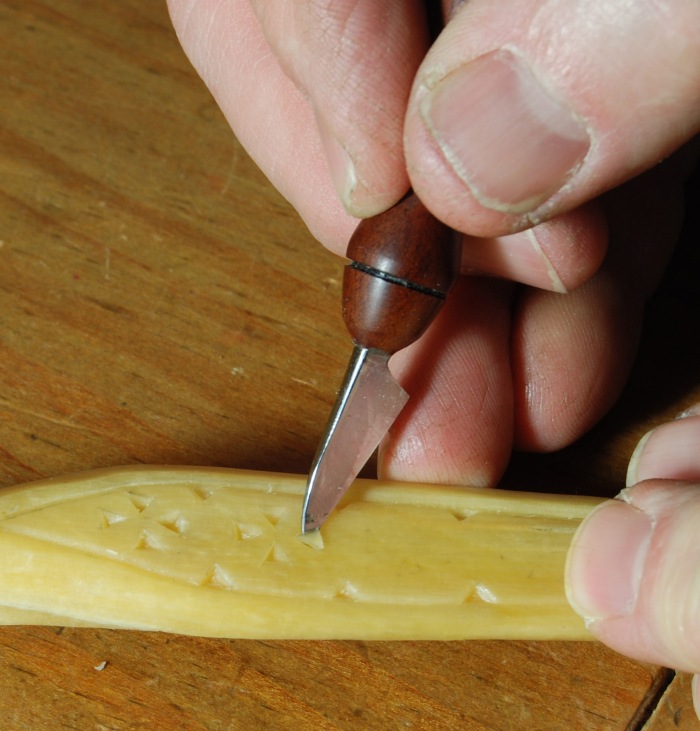People have asked about the chip carving on my spoon handles.
I mostly learned this through trial & error. I had seen Jogge & Wille demonstrate it in their classes, but as I recall we didn’t really spend much time on this aspect. I cut mine deeper than what I have seen on theirs…and there’s folks who do it closer to what Wille does. I think of Jan Harm ter Brugge – http://www.houtvanbomen.com/HoutvanBomen/English_text_spoons.html
Chip carving is something I’ve never addressed here, principally because it’s hard to photograph – all the shots I used to take in the workshop were easy to stage, then shoot with a remote to trigger the camera. Here it’s all tight shots, and hard to tell what I’m going to get because I hold the spoon and knife in my hands…and they shift around. Oh well, that’s my excuse anyway. I got some of it last night. so here goes
The tools first of all – from top to bottom:
Del Stubbs’ detail knife, 5/8″ – my favorite for this work.
A Frost sloyd knife I’ve had for 26 years. This used to be the only tool I had for the carved decoration. it works.
A Svante Djarv detail knife. I’m still getting the hang of this one. Called an “engraving knife”
another Del Stubbs knife – I don’t see it in this form on his website right now, maybe it’s the same blade as his kolrosing knife. I got it from Country Workshops, where Drew calls it an engraving knife.
First tool I use is a pencil – I know, I’ve chased some of you away in joinery class for using pencils, but here they’re allowed.
So I used the Frost knife just to show you can cut this stuff just with the tip of your knife. It HAS to be as sharp as you can get it, out to the tip. Usually I oil the spoon first too, that helps. This particular spoon is birch, and sometimes it almost looks like cow horn. The knife was working fine, I was not too thrilled with the texture of the wood… I wear a visor w magnifiers that I got from Lie-Nielsen. I get older every day.
Just hold it like a pencil, and make two cuts angled towards each other to create a V-shape shaving coming out of the wood. I stab in stop cuts at each end of the line first.
Here I’m using the Stubbs detail knife to cut 3-sided chips, this is what I think of as “real” chip carving. This knife has a very thin blade. Fragile, but outstanding.
a detail.
Between the previous photo and this one below, I have swung the knife along the line.
and here’s the shaving I removed.
——————
A couple of spoons are left from last week. I’ll then have more soon. https://pfollansbee.wordpress.com/spoons-for-sale-march-pt-2/
here;’s the links to where I got my knives
http://countryworkshops.org/knives/knives.html
http://www.pinewoodforge.com/catalog.html
BIRDS
The Great Horned Owls are sitting higher up, I wouldn’t be surprised if the chick(s) have either hatched or are about to… I haven’t had much time to hang out there to see what’s up.












I wouldn’t have thought that spoon needed chip carving, but now that I see it, it’s hard to imagine the spoon without it. perfect combination.
Just for the poor carvers out there – Jan Harm ter Brugge recommends making your own knife using a ground down hacksaw blade – about 45 degrees across the depth of the blade, somewhat like the bottom Del Stubbs above, but without the curves.
Nice instructions. Thanks for posting.
Great post, thank you. I think I may be able to take another “stab” at it now.
Great post Peter! I have been thinking of giving this a try but didn’t know where to begin. This should definitely help.
Peter, I’m also a bit perplexed by that Stubbs “Engraving Knife”. Looking at that alongside the Kelrosing knife, the blades and handles are definitely differently, and it’s not like the Stubbs detail knife I already have.
I’m trying to woek out an alternative to burning feather detail (or fur detail) in bird and animals carving, and Kelrosing seems like a possibililty. The only wrinkle would be that the Kelrosing wold have to take place after the bird painting is done and before the last clear finish coat is applied.
Maybe the Stubbs “Engraving knive” would also do the trick, but I do not at all understand the description:
“The DS-08 engraving knife is a stout little beauty, intended for double pass, V-cut decorative incising.”
What’s the difference, other than the size (length.width, thickness) of the engraving knife.
Do you have any thoughts about the purpose and way I would use either of Del’s two knives on painted (small) bird feathers, veins and barbs?
This was a link sent to me by a friend, and I’m so glad he did. Many thanks for sharing I have found this invaluable :-)
Thank you for sharing this information!